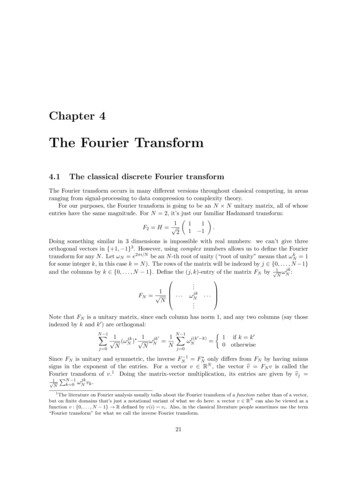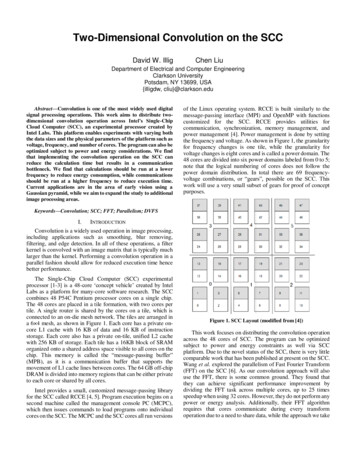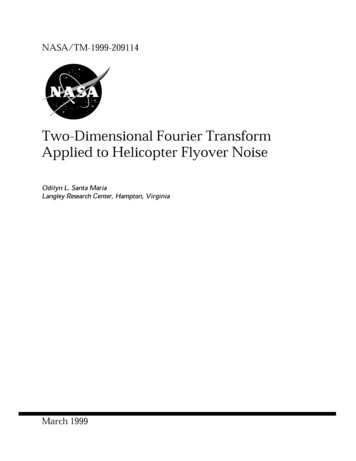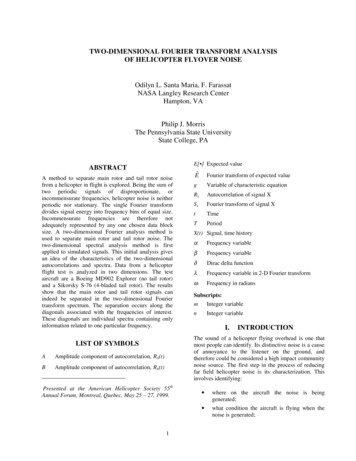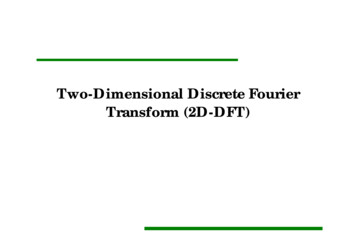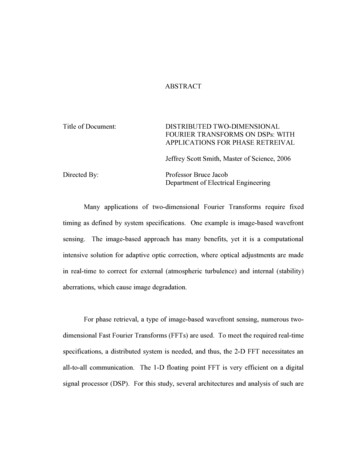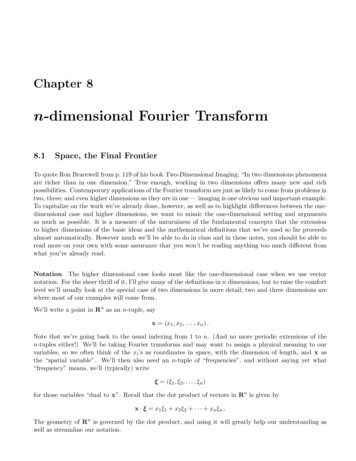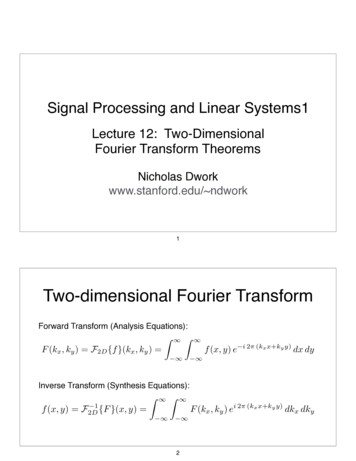
Transcription
Signal Processing and Linear Systems1Lecture 12: Two-DimensionalFourier Transform TheoremsNicholas Dworkwww.stanford.edu/ ndwork1Two-dimensional Fourier TransformForward Transform (Analysis Equations):F (kx , ky ) F2D {f }(kx , ky ) Z11Z1f (x, y) ei 2 (kx x ky y)dx dy1Inverse Transform (Synthesis Equations):f (x, y) F2D1 {F }(x, y) Z11Z112F (kx , ky ) ei 2 (kx x ky y) dkx dky
2D Delta FunctionZ11Z1(x, y) dx dy 11(x, y) 0for all(x, y) 6 (0, 0).3Sifting PropertyZ11Z1f (x, y) (xx0 , y14y0 ) dx dy f (x0 , y0 )
2D Delta Line FunctionRecall: the general equation of a curve in a plane is C(x, y) 0.The support of the delta function is a curve.(C(x, y))5Separability of 2D Delta Function(xProof:Z11Z1x0 , yf (x, y) (xy0 ) (xx0 ) (yx0 ) (yy0 )dx dy 1 f (x0 , y0 ).6Z11y0 )f (x0 , y) (yy0 ) dy
Strength of 2D Delta Line FunctionConsider a double integral encompassing an area of the curve:limArea!0Strength(x,y) ZZ(C(x, y)) dx dyAreaLength of curve in integrated area7Recall:(ax) (1/ a ) (x)The strength of a delta line function is a .Consider the following delta line function:(f (x, y)).The strength of the delta line function at the point (x, y) is rf (x, y) where r means gradient.8
ExampleF2D { (x)} Z1eZ11i2 ky yZ1(x)ei2 (kx x ky y)dx dy1dy (y).19Separable FunctionsA function f : R2 ! C is separable means there exists fx , fy : R ! Csuch that f (x, y) fx (x) fy (y) for all x, y.For a separable function, F2D {f } F1D {f1 } F1D {f2 }.Proof:F2D {f }(kx , ky ) Z Z111Z1fx (x) fy (y) ei2 kx x ky ydx dy1fx (x)ei2 kx x110dxZ11fy (y) ei2 ky ydy.
Example (x, y) 1 if x 0.5 and y 0.50 otherwise (x, y) (x) (y)F2D { (x, y)}(u, v) F1D { (x)}(u) F1D { (y)}(v) sinc(u) sinc(v).11F2D12
Theorem: Fourier CompositionF F2D {f } F1D,x {F1D,y {f }}Proof:F1D,x {F1D,y {f }} F1D,x Z11Z1f (x, y) e Z1i 2 (kx x ky y)f (x, y)ei 2 (ky y)dy1dx dy1 F2D {f }.Similarly, the inverse two-dimensional Fourier Transform is the compositionsof inverse of two one-dimensional Fourier Transforms.13Examplef (x, y) (x) (xy).F2D {f } F1D,x {F1D,y { (x) (y F1D,x { (x) F1D,y { (y F1D,x (x) e sinc(ui2 xvv).14x)}}x)}}
Scaling TheoremF{f ( x, y)}(kx , ky ) 1F{f } kx ky, Proof: Left as an exercise.More general scaling theorem: let A 2 R2 2 . 1xF f A(kx , ky ) F{f } Ay det(A) T kxky 15Corollary: Rotation TheoremA rotation is defined as matrix whose determinant is 1.A rotation matrix is orthogonal: its inverse is its transpose.Let R 2 R2 2 be a rotation matrix. xkxF f R(kx , ky ) F{f } RykyIn words: “Rotating the function rotates the Fourier Transform of the function.”16
Z11Z1f (x, y) (x cos( ) y sin( )l) dx dy1 This integrates f along the linedefined by the support of the delta.fIt’s another way of integrating alonga curve.17Radon TransformR{f }(l, ) Z11Z1f (x, y) (x cos( ) y sin( )l) dx dy1The value of R{f }(l, ) is the integrationof the function f along a line a distance laway from the origin at an angle .l 18
Radon Transforml Sinogram19Consider the value of the Fourier TransformF (u, v) v 0 ZZ1111Z Z 1f (x, y)ei2 (ux 0y)dx dy11f (x, y)dy e1{z}i2 uxdxProjection along vertical linesR{f }(x, 0) Z11Z1f ( , y) (x120) dy d Z11f (x, y) dy
F (u, v) v 0 Z11 Z 1f (x, y) (x) dy e1{z}i2 uxdxProjection along vertical linesF (u, 0) F1D { R{f }(l, 0)}The horizontal line through the 2D Fourier Transform equals the 1D FourierTransform of the vertical projection.Since rotating the function rotates the Fourier Transform, the same is truefor projections at all angles.21Fourier Slice TheoremThe Fourier Transform of a Projection is a Slice of the Fourier Transform.22
F1DTaking the Fourier Transform of projections at different angles gives manydifferent lines of the Fourier Transform.F2D1This is Fourier Tomography.2324
The horizontal line through the 2D Fourier Transform equals the 1D Fourier Transform of the vertical projection. Since rotating the function rotates the Fourier Transform, the same is true for projections at all angles. F (u, 0) F 1D {R{f}(l, 0)} 21 Fourier Slice Theorem The Fourier Transform of a Projection is a Slice of the Fourier .


